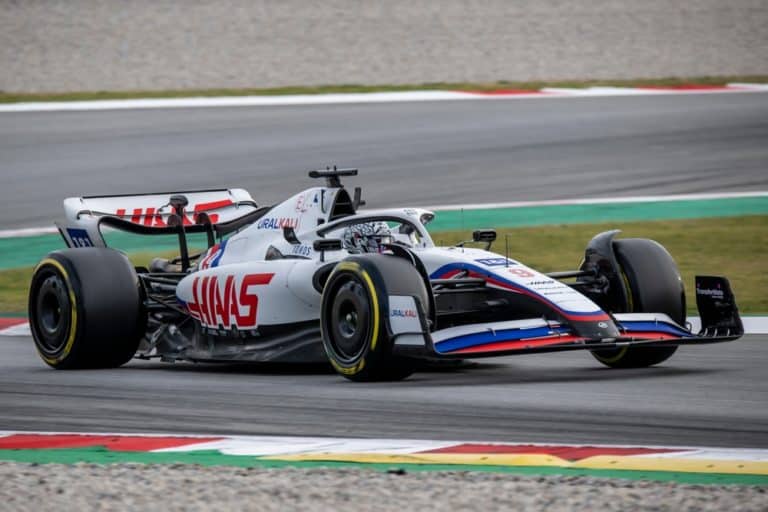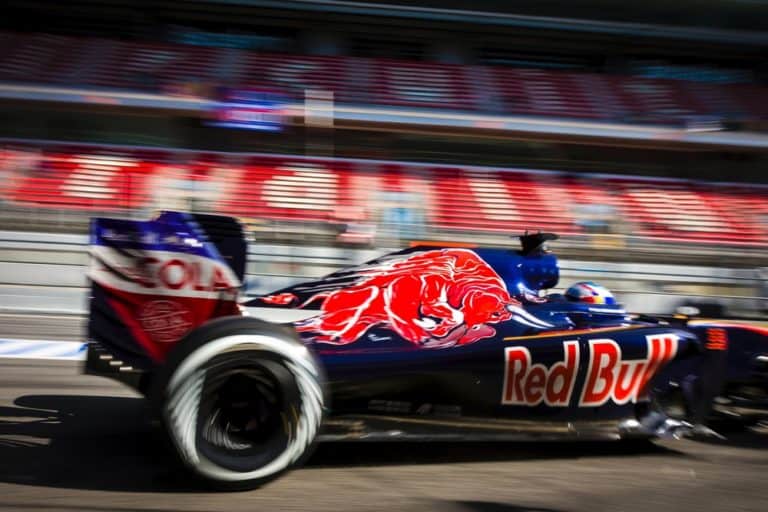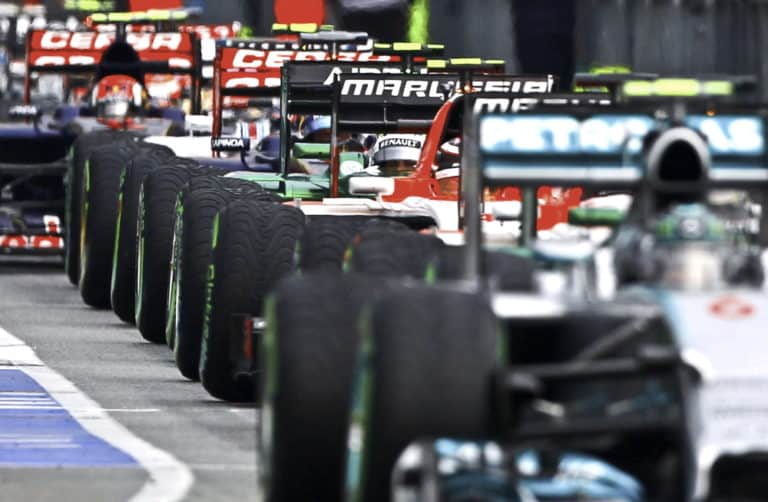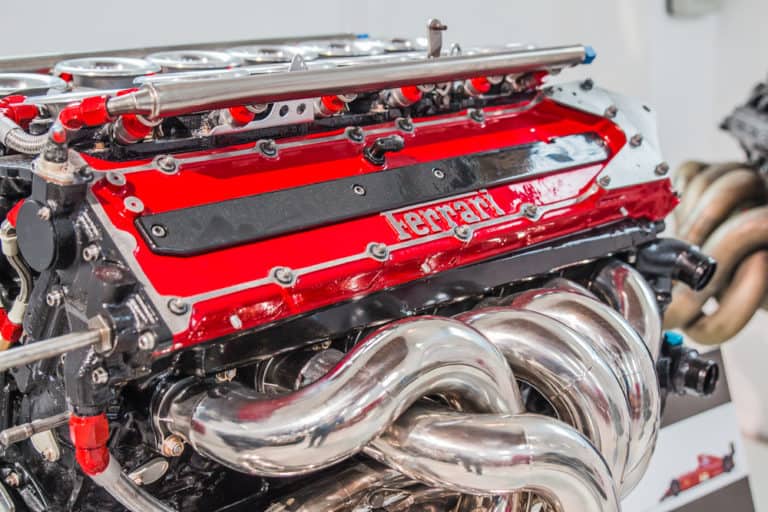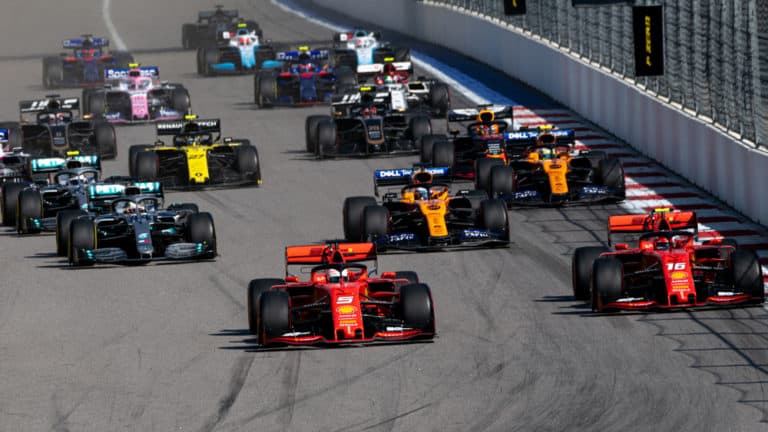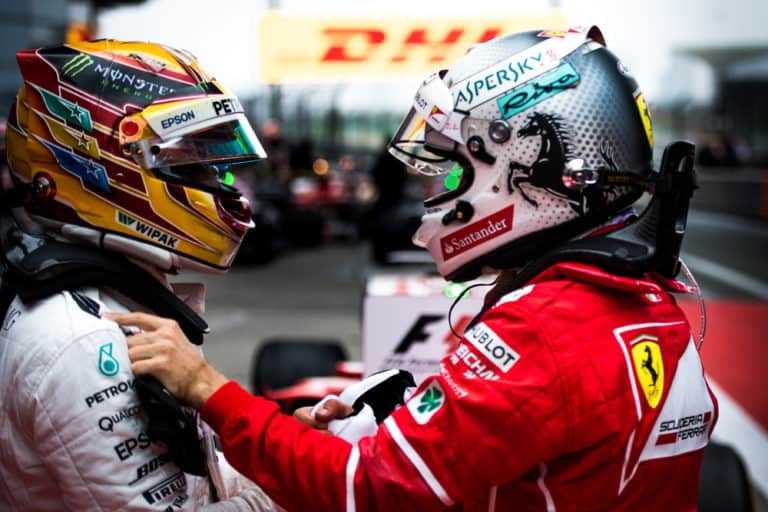Formula One has seen some great seasons previously, with it being one of the most exciting, high-stakes sports in the world. In this list, we look at some of the best F1 seasons and rank the top 12.
If you’re looking for some F1 merchandise, check out the awesome stuff at the official F1 store here.
12. 1958
This list begins with a big throwback. 1958 was an exciting year for Formula One. This season only had 10 races while still having five different winning drivers. The championship race came down to a two-horse race between Tony Brooks and Stirling Moss. Moss won the first race of the calendar in Argentina and the third race in the Netherlands.
Brooks went on to win in Belgium before the two shared the last four races between them. Moss winning in Morocco meant he won four out of the ten races. This was not enough for the title.
This season sticks out because it showed early Formula One teams how important durability was to win the championship. Brooks managed to finish second in the championship despite only finishing four races. A driver only finishing 40% of the races in a season would never happen today, so it proved how important a car’s durability is.
If Brooks had finished more than four races, he could have beaten Mike Hawthorn to the title. Hawthorn only won one race all season, but his car’s durability meant he finished on the podium seven times, finishing the season one point above Stirling Moss.
11. 2016
We jump ahead quite far for the next season. The Hybrid era has been dominated by one team and one driver, Mercedes and Lewis Hamilton. Hamilton has won all but one of the titles in the hybrid era. 2016 was the year in which his teammate defeated Hamilton.
Nico Rosberg had battled with Hamilton throughout 2014 and 2015 but to no avail. 2016 produced the most exciting title race in the hybrid era. The two teammates even came to blows at one point. The 2016 Spanish Grand Prix is one of the most memorable races in the hybrid era due to a massive incident on lap one.
Hamilton had pole position, but Rosberg overtook him going into turn one. Hamilton had a much better exit towards turn three, but Rosberg closed the door on him, pushing Hamilton onto the grass. Hamilton spun and took out Rosberg as the two were both out on lap one.
The crash early on only intensified the rivalry, which the two consistently play down. Rosberg benefitted from better durability than Hamilton, with Hamilton failing to finish the race in Malaysia. This meant that despite Hamilton winning the last four races, it was not enough for the title.
Rosberg finished second in all four of those races, enough for the German to win his first and only championship. Rosberg shocked the Formula One world when he retired after this season.
10. 2021
This might be a pretty controversial decision, but we have seen one of the best seasons in Formula One so far. The Hybrid era has disappointed so far, with Mercedes dominance often getting in the way of a close title race. 2021 will be remembered as the year in which Red Bull finally stepped up in the Hybrid era to produce an excellent title race between Max Verstappen and Lewis Hamilton.
The two have produced incredible racing, with the two winnings all but three of the races this season. The most exciting part of their rivalry has been the on-track racing. Hamilton won in Spain after a dominant fightback, while Verstappen had some exciting wins in the USA and Austria. The part that has made this rivalry interesting is the on-track collisions.
The two drivers came together first at Silverstone, as Verstappen was sent into the wall at Copse that saw Verstappen out of the race. The two collided again in Italy, seeing both drivers out in a scary-looking collision at turn 1, as Hamilton’s Halo being the only thing between Hamilton and Verstappen’s floor.
While this season may not have seen as many huge surprises as other seasons, it still has to be considered amazing. We have seen a truly exciting title race in the hybrid era, something this era of Formula One has been lacking. The wheel-to-wheelery is something we haven’t seen from title contenders since 2016.
9. 2007
There is no doubt that Kimi Räikkönen’s 2007 championship is overshadowed by the greatest rookie season in Formula One we have ever seen. But you have to remember that the 2007 season produced an incredible three-driver title race that came down to the very last race.
It seemed like Lewis Hamilton was on course for a title in his first season in Formula One with two races to go. Lewis led the championship by 12 points over Fernando Alonso and 17 points over Kimi Raikkonen.
In the penultimate race in China, it was heartbreak for Hamilton. Lewis spun off as he entered the pit lane and did not finish. Raikkonen won the race, with Alonso finishing third. Hamilton’s luck got worse in Brazil, as he struggled with gearbox problems to finish seventh. Raikkonen won again, giving him enough points to beat Hamilton and Alonso to the world championship.
Formula One had one of the closest-ever title races in 2007, with the top 3 separated by 1 point. There were so many what-ifs this season, and Hamilton’s poor luck in his last two races meant Kimi could claim his first and only world championship. It meant that Hamilton was just a point offsetting Formula One history, but he managed to overcome this early adversity.
8. 1982
One of the things that can create an amazing season is parity. It is a big reason why the hybrid era has been considered slightly more boring than previous eras. It can get boring when the same driver or team wins every time. This certainly was not the case in 1982.
1982 brought eleven different winners from seven different teams. But the most incredible stat of all, which shows how even the championship was, is that the driver’s championship winner Keke Rosberg only won one race all season in the 1982 Swiss Grand Prix.
The season began with many controversies, as water-cooled brakes allowed some cars to race under the minimum weight of 580kg. As these brakes were allowed to be refilled before weighing, it meant teams could run under the minimum weight during the race. It was not until the fifth race of the year that these systems were outlawed.
The season was also marred with some tragedy, as Gilles Villeneuve sadly lost his life at the Belgian GP qualifying. It was a season that was certainly marred by tragedy, as rookie Riccardo Paletti also lost his life at the Canadian Grand Prix.
The main reason why Rosberg won was that his main competition Didier Pironi suffered a career-ending injury in a practice session at Hockenheim. It meant that Rosberg was able to cruise through to the championship.
7. 2010
After one of the most surprising championships wins ever, in 2009, 2010 produced an even more interesting title race. With two races to go, five different drivers could still win the title, and it all came down to the last race of the season. This season without anyone driver taking a commanding lead. Sebastian Vettel, Fernando Alonso, Mark Webber, Lewis Hamilton, and Jenson Button all won races in the first seven races.
After Brawn dominated the 2009 season, the race for both championships was a pretty even affair. After the Red Bulls clashed in Turkey, it seemed like McLaren or Ferrari could take control of the championship. It seemed like Fernando Alonso had done that. He won three out of four races after Belgium, including in Korea, when Vettel retired. Alonso headed to Brazil with a 25-point lead in the championship over Vettel.
Vettel won in Brazil, but Alonso’s third place meant he only had to finish third to secure his third championship and first with Ferrari. It meant that the title came down to the last race. The final race could have seen Vettel, Alonso, Hamilton, or Webber win the title. Alonso had an eight-point lead, but his Abu Dhabi race could not have gone any worse.
Alonso pitted early and became stuck behind Vitaly Petrov. It meant that Alonso finished the race seventh. Vettel’s win meant he finished the season first, winning his and Red Bull’s first title.
6. 1994
As has happened in other years across Formula One, 1994 was a memorable year for some right and wrong reasons. The sport was left with a huge hole to fill when Ayrton Senna crashed at Imola, leading to his untimely death. Senna was already a three-time F1 champion, and he is remembered fondly as one of the most talented and exciting drivers ever to grace Formula One.
The season was forced to continue after the death of Senna, and it came in the same season that we saw the rise of Michael Schumacher. Schumacher had been in Formula One since 1991, and his Benetton car seemed to have found its form in 1994. Schumacher began the season winning six out of the first seven races.
Schumacher’s dominance was marred by disqualification at Silverstone after Schumacher overtook Damon Hill on the formation lap and then ignored black flags. Schumacher was again disqualified at the Belgian Grand Prix.
The German had finished the race in the first place but was disqualified after the race, as there was excessive wear on the wooden skid block on the underside of Schumacher’s car.
Throughout Schumacher’s struggle, Damon Hill appeared as a serious contender for the 1994 world championship. The two raced wheel to wheel rarely throughout the season, but Hill won four out of five races after the summer break to give himself a chance at the championship in the final race in Adelaide.
Hill was just a single point behind Schumacher in the championship, and the two lined up in 2nd and 3rd on the grid. The championship leaders collided while battling for the lead, sending them both out. This is remembered as one of the most controversial endings to an F1 championship, as the crash meant Schumacher won the title over Hill.
5. 2008
Once again, Lewis Hamilton entered the 2008 season looking to make history. Having narrowly missed out on winning a title in his rookie season, Hamilton still had the chance to do something incredible, win a title in his second season.
The season began perfectly for Lewis, claiming victory in Australia. But Hamilton only won one of the next seven races, with Ferrari driver Felipe Massa claiming three of those six. It seemed like Hamilton would have to defeat Massa, and 2007 world champion Kimi Raikkonen, leading the championship after four races.
After an impressive win in Monaco, Hamilton looked like he began losing control of the championship after back-to-back pointless races in Canada and France. His Canada race was particularly poor, as Lewis crashed into Kimi Raikkonen’s Ferrari in the pitlane. Hamilton’s luck worsened in Belgium, as he won the race before being penalized 25 seconds for cutting the chicane, meaning Hamilton was awarded third, behind Massa.
As Räikkönen’s form dipped, Massa became Hamilton’s main rival, and both had a chance of the championship win at the final race of the season, Massa’s home race of Brazil. The race produced one of the most exciting final laps in F1 history. After all of the top six had stopped for intermediate tires, Hamilton needed to finish fifth to secure the championship but was stuck behind Vettel in sixth place. All but one driver.
Massa crossed the line to finish first, with his Ferrari garage celebrating what they thought was the Brazilians first championship. But Hamilton passed Glock in the final few corners to secure fifth, as Glock had not stopped for intermediate tires. Hamilton crossed the line fifth as the Ferraris garage turned to disappointment as Hamilton claimed the title in the last few corners.
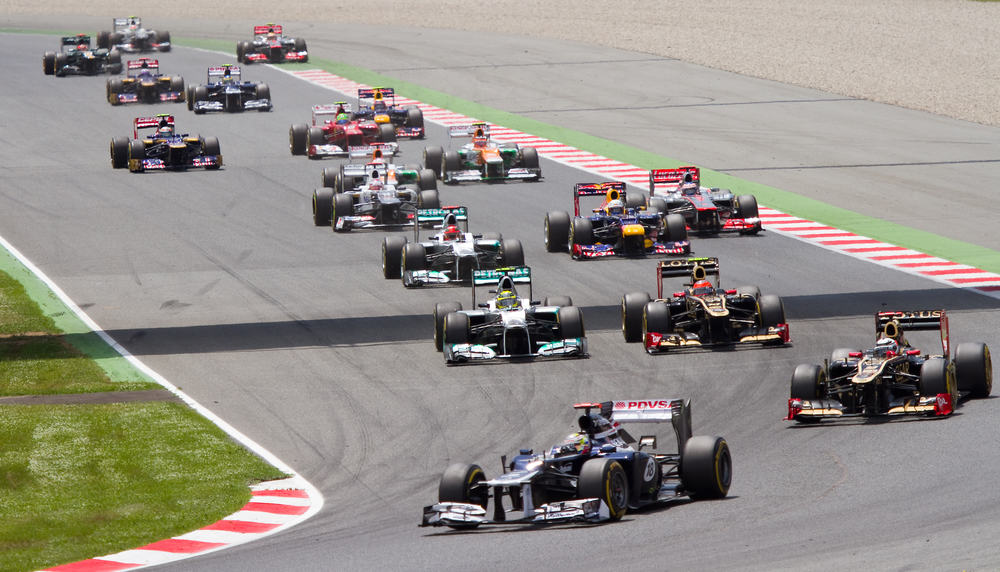
4. 1986
1986 is remembered as one of the most thrilling seasons in Formula One history. This season featured legendary drivers like Alain Prost, Nigel Mansell, and Nelson Piquet. Prost was coming off the back of winning the title in 1985 but seemed to have little chance to win due to the powerful Williams that had Nigel Mansell and Nelson Piquet at the wheel.
William’s year started tragically off the track. The team’s founder Frank Williams was paralyzed after a road accident. Early on in the year, Mansell was able to lift the spirits of Williams, with wins in Belgium, Canada, and France al leading up to a historic victory at Silverstone.
The three drivers all shared wins throughout the season, with no one, in particular, taking any significant lead. Piquet’s retirements in Belgium, Spain, USA, and Austria meant he had a slim chance of winning the title, but any of the top three had a chance at the title in Adelaide, the last race of the year.
1986 became another year where the title was decided in Adelaide, and this race is remembered for heartbreak for Mansell. Mansell was running in third, enough for him to secure the title. But with just 18 laps remaining, Mansell’s race was ended by his left rear tire exploding.
It meant that Prost won his second title in a row, having beaten Piquet to the line. It was a heartbreaking end to the season for Mansell, who had to wait until 1992 to claim his one and only Formula One world championship.
3. 1984
Like many other seasons on this list, the 1984 championship was an incredibly close title race decided by just half a point. The driver’s championship was always a two-horse race between Alain Prost and Niki Lauda. 1984 stands out more so because of the incredible story of Niki Lauda and how impressive it was that he was even in a Formula One car in 1984.
Eight years previously, while Lauda was driving for Ferrari, he swerved off the track at the Nürburgring. His car hit the barrier and burst into flames, with Lauda trapped inside the wreckage. Lauda was pulled out of the car by Italian driver Arturo Merzario but still suffered severe burns to his head and inhaling toxic gases. Despite major scarring and losing most of his right ear, Lauda somehow managed to survive.
The most incredible part was that Lauda only missed two races. After winning the title the year after the accident, 1984 was Lauda’s biggest test. Lauda and Prost shared wins throughout the season, with the title race coming down to the last race. Lauda needed to finish second in Portugal and did so. It meant that Lauda claimed the title by just half a point, the smallest title-winning margin in Formula One history.
2. 1976
If a Formula One season has a movie based on it, you would have to imagine it was an outstanding season. This was the case for the 1976 season. 1976 is remembered for one of the greatest rivalries in Formula One history, between Niki Lauda and James Hunt. If you have seen the film Rush, you will know a lot about this season.
Lauda took control of the championship, being in the top two of the first six races. But the season was thrown on his head after Lauda’s fiery crash at the Nürburgring. It was an incredible feat for Lauda to return as quickly as he did, only missing two races despite doctors believing that Lauda would die due to his severe burns. Somehow, Lauda returned, and both Lauda and Hunt had a chance to win the title in Japan.
The ending to this championship is one of the most controversial endings of a season of all time. Lauda had the lead heading into Japan, but heavy rain meant the race was a doubt even to begin. After organizers decided to go ahead, despite the disagreements of Lauda and other drivers. Lauda then made a title-winning decision. Lauda withdrew to the pits on lap two, believing the track to be too dangerous. Hunt went on to finish third, giving him the title.
1. 2012
Look, there may be some recency bias to 2012 being number one. But this season had it all. From an exciting title race, surprise wins, and massive amounts of drama. The season was set up to be spectacular, as there were six world champions on the grid, with five of them being serious title contenders.
The season started spectacularly, with seven different drivers winning the first seven races of the year. The most spectacular of these came from Spain. Home favorite Fernando Alonso was out-qualified by Pastor Maldonado, who claimed the first pole position of his career.
Alonso took the lead of the race on the first lap, but thanks to some excellent pit stop management, Maldonado took the lead of the race and did not let go. This is still Williams’s only win since 2004, with Maldonado only finishing above 8th once the whole season, other than his win in Spain.
Fernando Alonso was the first repeat winner of the season and looked to have taken control of the championship after a win in Germany. 2011 champion Sebastian Vettel struggled after his win in Bahrain. After a late retirement in Italy, Vettel was 40 points behind Alonso. What happened next was one of the most impressive performances. Vettel won four races in a row, as he closed the gap on Alonso and had the lead in the championship heading into the final race in Brazil.
Vettel crashed on the first lap in Brazil, leaving his car in last place. Vettel’s car had damage to it, yet Seb could still battle back through the field up to sixth. It was just enough for the title, as Jenson Button held off Alonso for the race win. It meant the German finished three points ahead of Alonso, giving Vettel his third title in a row.
2012 featured some incredible exciting races and storylines. There were Hamilton’s seasons being ruined by poor McLaren reliability, Michael Schumacher struggling in his final season in Formula One, and the fallout of a massive crash on the first lap of the Belgian Grand Prix. 2012 was the season that got me into Formula One, and in my opinion, has to be regarded as the greatest ever Formula One season.
Sources
- https://www.motorsportmagazine.com/database/championships/1958-f1-world-championship/
- https://www.skysports.com/f1/news/12516/10283142/2016-spanish-gp-max-verstappen-wins-after-both-mercedes-crash-out
- https://www.formula1.com/en/results.html/2016/races.html
- https://www.formula1.com/en/latest/article.hamilton-overcomes-first-lap-collision-with-verstappen-to-hunt-down-leclerc.AgFOAxlzlpWSTiHS0Hsbe.html
- https://www.motorsportmagazine.com/database/championships/1982-f1-world-championship/
- https://www.motorsportmagazine.com/database/championships/2010-f1-world-championship/
- https://www.motorsportmagazine.com/database/championships/1994-f1-world-championship/
- https://www.motorsportmagazine.com/database/championships/2008-f1-world-championship/
- https://www.motorsportmagazine.com/database/championships/1986-f1-world-championship/
- https://www.motorsportmagazine.com/database/championships/1984-f1-world-championship/
- https://www.motorsportmagazine.com/database/championships/1976-f1-world-championship/

